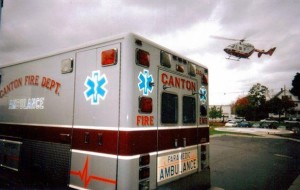Canton no stranger to growing opiate epidemic
By Jay TurnerEditor’s note: The names of two interview subjects have been changed to protect their privacy.
It has ravaged families across the region and ripped away loved ones in the prime of their lives. It cuts across all racial, gender, and socioeconomic lines and has found its way into every corner of the state, from the biggest cities to the smallest towns and everywhere in between.
It is the scourge of opiate addiction, and according to newly elected Governor Charlie Baker, it stands as one of the commonwealth’s “most pressing public health emergencies” and a primary focus of his administration in his first term in elected office.
On February 19, roughly a month after he was sworn in as the 72nd governor of Massachusetts, Baker unveiled the first steps in his plan to tackle this growing epidemic, including the establishment of a 16-member Opioid Addiction Working Group and a call on insurers to more effectively monitor opioid prescriptions.
Meanwhile, the new attorney general, Maura Healey, recently launched a new opiate and prescription drug abuse task force as her first major initiative, and Norfolk County District Attorney Michael Morrissey kicked off his second term with a renewed commitment to the crisis following the implementation of several successful programs in his first term as DA.
Sizing up Canton’s drug problem
“I don’t think, per capita, we’re any better or worse off than anyone else,” declared Canton Police Chief Ken Berkowitz when asked about the rate of drug and alcohol abuse in Canton, particularly among teens and young adults.
Still, with overdose cases on the rise and more than a dozen opioid-related deaths in the town in the last five years, Berkowitz sees an alarming trend that warrants the community’s undivided attention.
“Even if we lose one kid a year, it’s huge,” he said. “In fact, I would say that there’s no bigger problem.”
From a statistical standpoint, Berkowitz said it is difficult to properly gauge how many young people are currently using drugs and alcohol in Canton; however, he strongly suspects that it’s more than the number gleaned from the latest Youth Risk Behavior Survey, which found marijuana usage rates of 18 percent among high school students and 4 percent among middle schoolers.
“I don’t think it’s accurate at all,” Berkowitz said of the 2013 survey. “I think it’s way under [reported].”
Regarding heroin and other opiates, the police chief did not have any town-specific usage data; however, Fire Chief Charlie Doody said that Canton EMS personnel typically administer naloxone — which is used to reverse the effects of an opiate overdose — between two and three times per month.
“Ten years ago, we responded to maybe half a dozen [overdoses] a year,” said Doody. “Now we’re doing somewhere in the vicinity of 30 or 40 per year.”
Doody added that most of the opiate cases they encounter involve young adults, typically in the 18-28 range, which is consistent with the anecdotal evidence obtained by the Citizen through a series of recent interviews.
Of the three young adults who agreed to share their stories, in fact, all three said they began using prescription pain medication recreationally before progressing to heroin, and only one of the three said they used heroin while in high school.
All three also said they knew of several other young adults in Canton who used or still use opiates, with one individual estimating the number of friends and acquaintances at between 20 and 25.
“Literally all of my friends have done drugs,” said Jessica. “I think it’s a really big problem. I moved [out of state] and it was the same problem. Everybody was on drugs.”
All three also said that illicit drugs, including heroin and synthetic opiates such as Percocet and Oxycontin, were easily obtainable in Canton and in surrounding communities such as Stoughton and Randolph.
“It’s everywhere,” acknowledged Ryan. “Some people think just because they’re in a nice town that nothing like that happens, but I mean, heroin is everywhere. You can probably get anything you want anywhere.”
Michael’s story
There is a saying in recovery circles that substance abuse has only three possible outcomes: “jails, institutions, or death.”
And by age 24, Mike Brissette had already had brushes with all three, having spent time behind bars and in psychiatric facilities while also coming to grips with the loss of his younger brother, Eric Breyan, who died of a heroin overdose at age 19 in January 2013.
Brissette said his relationship with his brother had fractured years earlier, in part because of his own drug addiction, and for a long time he blamed himself for Eric’s death and was wracked with “extreme, extreme guilt.”
He also harbored deep feelings of guilt over the way he treated his family, recalling that he stole “thousands and thousands of dollars” from them to support his habit.
“If someone is desperate enough, they will do anything without thinking about the consequences — the pull is almost magnetic,” he explained. “It’s being selfish to the most extreme point that you can. It’s not that you don’t care about your family, but you shut those feelings off just to get through the day.”
Brissette said he continued to use opiates until about a year ago, when he finally hit rock bottom and made the decision to quit cold turkey.
“Between my brother passing, between all the money I blew on it, all the pain that I brought on the people around me, it finally hit me all at once one day,” he said. “But I’m very lucky I was able to stop in that way because it is very, very rare.”
Today, Brissette said he feels like he has taken a “180-degree turn,” aided by meditation and other spiritual pursuits, although he knows there are always going to be “ups and downs.”
“It’s still an everyday struggle for me,” he said. “It would be very, very easy to slip back into it, which is why I have to be extremely vigilant with myself and extremely honest about how I am feeling.”
Jessica and Ryan
Both Jessica and Ryan, much like Brissette, have their own unique stories, although both said they began experimenting with drugs and alcohol as early as age 12, primarily due to boredom and curiosity.
In Ryan’s case, he said that he drifted away from sports after suffering a series of concussions and started spending time with kids who were “messing around with weed and alcohol.”
Ryan said he was initially drawn to Percocets because they took his headaches away, but his habit quickly escalated to six or more 30-miligram pills a day before he made the switch to heroin.
“It really is a disease; it’s not just bad decision making when it gets to that point,” he said. “What I really want people to understand with addiction is that it’s really not an option when you’re hooked on a substance like that — not doing it is just not that simple.”
As for Jessica, she too progressed from occasionally taking Percocets to eventually injecting heroin. She then managed to get clean for two years before relapsing, although she said she is now “back on track.”
Both Jessica and Ryan, who were interviewed separately, said they believe that Eric’s death was a “wakeup call” for a lot of the people in their peer group, although they emphasized how hard it is to “get and stay clean.” Jessica said she also talks about Eric to her younger brother — how he played sports and had a lot of friends — in hopes that he will make better decisions than she did at that age.
Sadly, both said they know of at least one other person who has died from an opiate overdose, including a family friend of Jessica’s and a former close friend of Ryan’s at Canton High School, and both have experienced their own “close calls” that could have easily taken their lives.
If you can save just one …
In reflecting on why he gravitated toward drugs and alcohol at such a young age, Brissette said he was reminded of his years at Canton High School and the feelings of loneliness and alienation that consumed him at the time.
“For me it was a popularity issue,” he said. “The media puts out an image of what you should be like and it’s a very cookie-cutter image and it doesn’t allow for a lot of individuality.”
“What the adults can do is really try to get their kids to be more accepting and more welcoming of other people,” he suggested. “You’re both human beings, you both bleed red, you both have feelings … If I had felt cared about and loved in high school I honestly feel that my life would have gone a lot differently.”
Ryan took it a step further, suggesting that marijuana, at least for some people, is truly a “gateway” drug — a sentiment shared by both the fire and police chiefs.
As noted by Berkowitz, “Virtually every single kid that dies from a heroin overdose or that’s hooked on pills started by smoking pot. You’re playing with fire.”
Berkowitz also lamented the relaxed legal restrictions and cultural attitudes toward marijuana, which he said “doesn’t make you faster, prettier, stronger, or funnier.” “If you’re a kid, why try it?” he said. “Why run the risk of having a substance abuse problem for the rest of your life, or in some case it could cost you your life.”
Along those lines, Ryan also suggested that it’s important not just to say “don’t do drugs and drugs are bad, but actually give kids some detail.”
“Talk to kids about Eric and tell them his story,” he said. “I think it’s important to know that you can’t just do this one time. It’s not just a one time thing.”
The good news, according to Berkowitz and Doody, is that the town now has an avenue to deliver these messages with the recent formation of the Canton Substance Abuse Prevention Coalition. Although still in its infancy, Berkowitz said the coalition has the chance to make a real impact in the coming years as it builds relationships with middle and high school age students with an eye toward prevention and education.
“Twenty-three years after [joining the police force], I’m not cynical about it,” said Berkowitz. “If you can save one or two kids — at least for a few hours when the kids are playing basketball or playing at the field, I know they’re not doing drugs for that time.
“Will it be a success? It depends on what you define as success. If you save one kid, is it worth it? If it’s your kid then it sure is.”
Short URL: https://www.thecantoncitizen.com/?p=28852












